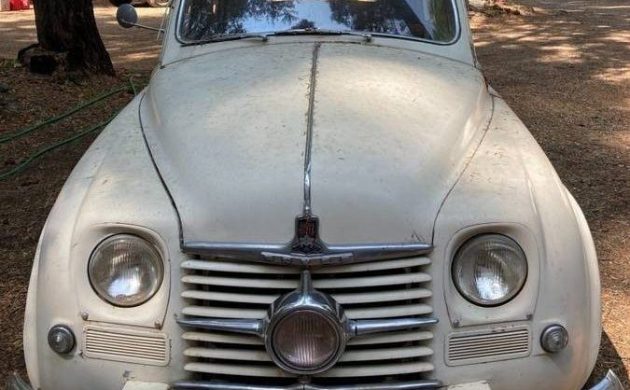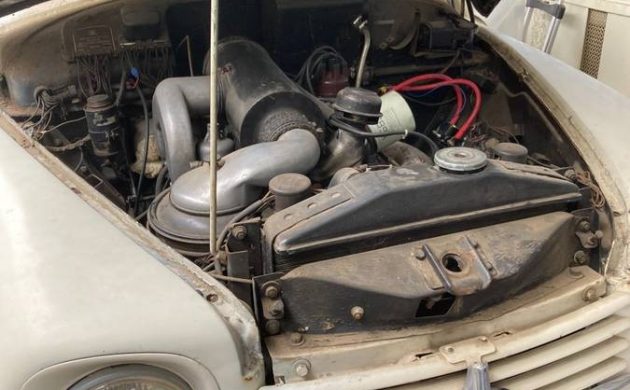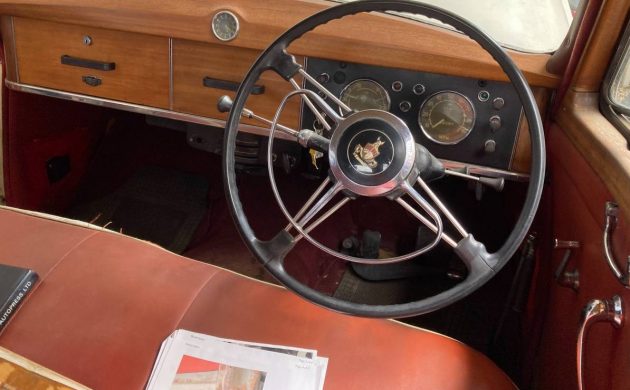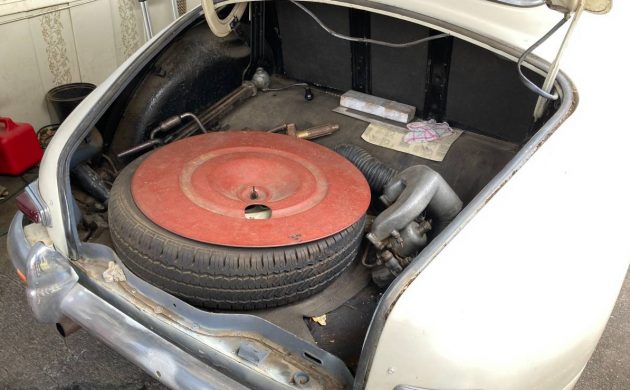Having a bit of Tucker about its front end is this 1951 Rover 75. Hailing originally, all the way from New Zealand, this suicide door-equipped sedan is now located in Shingletown, California and is available here on craigslist for $7,500. Thanks to Matt H. for this most unusual discovery.
Introduced in 1949, the P4 edition of the Rover 75 was a stark departure from its antiquated appearing P3 predecessor. It has been said that Rover borrowed styling cues from the 1947 Studebaker for their new design, a look that was most distinctive on account of its central eyeball headlight. Not universally appreciated, the cyclops styling was ditched for the 1953 model year. In production through 1959, approximately 43K Rover P4s were assembled.
The seller states that this Rover has been a U.S. citizen for some time, is in pretty good shape but could use a paint job. The finish is a bit worn and flat looking but it’s certainly presentable. The fact that it’s intact, not missing parts or trim, and minus any obvious body rot is a plus too. Apparently, there are extra parts included in the sale but they are not described or detailed.
Originally powered by a 75 HP, 2.1-liter, in-line six-cylinder engine, the listing states that a “6-cylinder long stroke and newer engine” is now in residence (what? no matching numbers?). The transmission is listed as a three-speed manual, column shifted affair but research suggests that the P4 was originally equipped with a four-speed manual. Regardless, it is stated that it runs but maybe doesn’t stop too well as it needs brake work.
Besides the obvious right-hand drive, the seller opines, “Has beautiful wooden dash and door panels, super cool signals and many beautiful details not found in more modern cars“. I must agree with the woodwork description, it is beautiful and has survived well for being 70 years of age. The glovebox door looks like a cigar storage box or humidor that one would see in a smoke shop. The seating upholstery has a sort of two-tone orange and red thing going on but that may be due to the tops of the backrests (sun damage?) being reupholstered in a non-matching fabric. All in all, it’s still a very presentable environment.
I always find the central headlight theme amusing. My brother owned a 1981 Sabaru that had a central passing light located behind a small door in the center of the grille. I believe that when engaged, the lid flipped open and the light flashed to warn a passee that you were the passer and coming on – it wasn’t something that you could leave on. And I wonder about that with this Rover, can it be illuminated separately from the headlights? If so, it might make oncoming drivers think they are encountering a motorcycle, or worse, a locomotive (OK, that’s a stretch). Anyway, this is a curious and interesting little car, the combination of the center light, right-hand drive and suicide doors just add to the fun, wouldn’t you agree?








Styling cues from a ’47 Studebaker? I don’t see it, even with my third eye. From the side I see style similarities with a Morris minor but with a more sloping rear. The front reminds me of a Saab 92. Maybe one gets this if a Morris minor and a Saab had a kid, an ugly kid. Genetics can be cruel.
From the front the car also looks a bit like an Austin A90 Atlantic.
Side styling cues appear to be from ’49-’50 Frazer. I have a weakness for obscure European sedans, glad this one isn’t near me!
I believe the interior wood was been milled more recently.
Thought these had a Freewheel attachment – certainly the later 50’s ones did.
i like the semaphores (I think I C than between the doors?) and spy a MB pontoon ? not Studi. Have to spend more time lookin at each.
I assume the 3 lghts come on, work simultaneously…
Thnx for the listing/write up Jim.
My first car was a 1952 Rover P4.
Those made in 1952 did not have the third eye.
It actually has 4 gears in the gearbox.
What is most different about this car is the freewheel option as in the DKW.
All moving parts of the body such as, doors, engine cover are made of aluminium.
12 volt electrical system.
And a very fun car.
I believe I still have the keys to mine today.
I owned a 1953 P4 Rover 100. It had the 4 speed on the column along with the ability to disengage the clutch. These cars came with aluminum hood , trunk, and doors in a feeble attempt to shave some pounds from its 4300 lb running weight. The engine is actually a Hemi six cylinder engine. producing about 100 hp from what I remember. It was a lot of car to get moving although once at speed of 50 mph or so it was rather comfortable. Sitting in the rear was quite luxurious. I’m thinking that it was designed and marketed as a poor mans Bentley.
Hemi engine? I thought that they were overhead inlet and side exhaust engines. L-head I think some call them. They were popular with some manufacturers until 1960s.
If you’ve never driven right-hand drive here in the States – or anywhere that left-hand drive is most logical – driving one is not what I would call “fun” until several days in various circumstances have been encountered.
I have a 1951 which I imported from Australia around 2005. The central light is a fog light, which is switched separately from the headlights. The central light configuration wasn’t road legal in the US at the time, so the small number which were sold here new had a chrome blanking plate in the center of the grille.
These were all four speed on the column, with freewheel. I’m not sure when the shift was moved to the floor and the freewheel deleted. It’s an interesting device and it does smooth out the drive, but it can be dangerous if not used carefully and needs to be disengaged when parking or the transmission is disconnected from the wheels, relying 100% on the parking brake.
For its era, this is a relatively powerful car with driving characteristics that are still usable in modern traffic.
The Rover P4 was actually made until 1964, not 1959. Around 130,000 of all models were made.
The initial designs were done by the Raymond Loewy organisation and Rover used the body of a 47 Studebaker to use as a mule with the development of the P4….seems it was known as a Roverbaker !
The P4 Rover 75
I’ve been driving these cars since I was ten and have owned them now for a total of 60 years ( applause). I’ve driven them 700,000 miles. So I do know a bit about them.
The P4 Rover overhead inlet and side exhaust motor dates back to 1939 and ran throughout the war to help get it ready for production.
The engine first went into the P3 which was a typical pre-war English style body based on the P2 but with the P4 75 running gear. In other words, Rover introduced their new model in 2 stages. The Rover clientele were a pretty traditional lot and by 1949 when the new 75 appeared they were not happy about its (dare I say it? )new-fangled American styling.
The motoring press in England received it with great joy however, and before long the arch- conservative Rover owners were won over.
It was definitely inspired styling wise by the Studebaker Champion of the late 40s. Rovers imported 2 Studeys to study and put the body of one of them on to a prototype p4 chassis. Hence the ‘Roverbaker’ as it was affectionately known at the works.
The doors, bonnet and boot were aluminium not primarily to save weight but because the British government put great restrictions on steel supply. That’s why the Land-Rover body was entirely aluminium throughout as well.
Meccano made very acceptable dinky toy models of both the Champion and the cyclops 75 and comparing them you can spot many similarities. The champion overall is longer and therefore looks more squat than the ‘perpendicular’ p4 Rover, described as such by Bill Boddy of Motor Sport who had a very high opinion of P4s. The whole tank- top, as I believe you Transatlantic gentlemen sensibly describe that section of the car, has clearly been lited from the Champion, as have the doors and rear wings. The downward sweep of the bonnet is pure Studebaker.The boot and rear window are not obviously that similar; the Studey’s boot does not slope down and the rear window is wrap-around.However, for the 55 season, guess what? A bit late, but the P4’s rear window has gone into a 3 section wrap-around style, and the boot raised up with a a much more squared off style. Pure Champion! (And this style continued right through then to 64 unchanged).The front wings, so very rounded at the front on the early P4s, were similarly squared off in David Bache’s revision in 56.
To turn to that cyclops lamp, p2 Rovers from 36 had this feature as an option, though as a separate fixture. It wasn’t an integrals part of the styling at that stage. Please note, for 99% of people in England get this quite wrong- the original dipping system in Blighty was fairly crude! When you dipped, the right hand headlamp went out! The left hand one hopefully was arranged to shine down on to the road. But a lot of people were careless with that! Rovers had a typical set up at that time which was a left hand fog lamp that was also the pass lamp. Not as in flashing to overtake but as in showing courtesy to the driver coming towards you who will not wish to be blinded as he passes by you. In the case of a centre lamp, that’s the pass lamp and both headlights go out, the motor cycle effect one of your correspondents alluded to.
I seem to be writing a book so Thankyou for your patience! Very briefly there were always 4 gears and a steering column gear change til March 52 when a floor gear change took over and the cyclops eye and distinctive grille disappe through ared.
The freewheel feature is not primarily for fuel economy as most people now think; with it engaged there is no engine braking so you can change gear without using the clutch and without any need to double de clutch with a crash gearbox. It’s terrific in traffic, but I’m not so keen on the open road. These days it would be irritating to drive behind someone using it, though they would get 10% maybe 15% more mpg.
Yes, the Rover was known as the poor man’s Rolls. It’s very quiet, refined and civilised especially with overdrive which was introduced originally on the 2.6 90. The build quality and standard of finish are both exemplary. The Rover Co had a wonderful reputation for high quality engineering all done in a family atmosphere. When the British government were looking for an exceptional firm to get Frank Whittle’s jet engine to actually through work, it was Rover to whom they turned. And they jolly well made it work too! Hence the gas turbine cars of the 50s.
I suspect most Americans are most familiar with the P6 Rover cars out of all of them; that was the 2000 and then the 3500 V8 that incorporated the Buick motor, much worked on under the watchful eye of Joe Turley the original designer.. But the car was originally visualised to have a gas turbine option too, hence the very wide bonnet and unusual front suspension design.
The P4 soon becomes away of life and a family pet; Rover is an apt name! It’s a safe car as it exerts a subtle influence on you to drive it well. It is delightful to drive. As Autocar said, it obviously comes from a good family.
Thankyou all for wading through the enthusiastic random rumblings of an old-timer from the old country.
Martin Gardener
..as a car mad teenager in the UK recall seeing the gas turbine P6 one day in the Cotswolds. The engine tone was so standout I stood and stared…it took off like a scalded cat …hopefully for my pleasure
Thank you for the Cyclops info..not only tied several bits of info I knew but some new one points too. I live in the UK and seeing a P4 or relatives always a pleasure
Just an update on anyone looking at this article. I have bought the car. The previous owners bought the car in the condition it currently is in with all the parts from an old mechanic that imported it from New Zealand some decades ago. The intent of the owners was to use it to haul vintage trailers as they restore them but they never got around to it. The reason it hasn’t sold until now it a combination of infrequent Craigslist posting as well as everyone aside from myself wanted the car shipped overseas as the home base of the P4 Driver’s Guild is in the UK. On to the car itself, unfortunately there’s more bad news than good but it’s all fixable in time on my budget.
THE GOOD
-Engine was rebuilt wonderfully it’s nearly dead silent at idle
-Carpet is in good condition
-TONS of extra parts including: NOS windshield and rear brake light glass, head gasket, front suspension springs, old dash, spare complete engine, random electronics, belts, carb, and a bunch of other parts I can’t remember off the top of my head I’ll update this post when I get time to take a look
Aaand that’s about it
THE BAD
-Radio was ripped out and a modern one jerry-rigged into place
-In addition to above the speaker was hacked out and a new one taped in
-Freewheel has been removed and I’m pretty sure to get it back in it’s an interior out job so that will have to wait
-Antenna was moved and hole sealed
-Tops of seats covered to hide decently bad deterioration (not enough to disfigure the shape but enough to say holy shit)
-Aftermarket seat-belts where installed so I personally don’t know how strong the B pillars will remain
-Rear left quarter panel was completely redone
-Car was repainted terribly, visible paint run is the least of the issues
-Rear left brake pulls hard enough to produce a fair amount of heat
-heat and air tubes are non existent
So yeah she is going to be hell to bring back where she should be but hopefully I’ll be able to bring her around.
Good luck with the restoration…..and I am sure the drivers guild will be able to help if needs be. Keep us all posted please !!
Many thanks for the updates from the new owner and for the useful insight from Martin Gardener. The original P4 Cyclops 75 was a beautiful sleek car that caused a sensation on launch: The motoring press and general public were interested, ‘traditionalist’ dinosaur Rover owners less so, they disliked the long (and roomy) boot (luggage space/trunk) slab styling and the Cyclops fog lamp which alas disappeared as did the sleek duck tail boot. Rover cars were in the 50s and 60s very well finished nicely engineered cars. Of course, by American standards and tastes these were mini compact cars with tiny engines and would never sell well. It’s worth remembering that British car makers had their steel allocation rationed by the govt. until mid 50s and they had to export 75% of cars for hard currency to pay off war debts etc. Domestic market was eager for cars but they were hard to come by yet trying to sell cars in the US unless sports or large Jaguars was doomed. Think of the Austin Atlantic debacle, many were shipped back to Britain unsold- unsurprisingly a small modest powered car that had no chance of interesting American buyers. Petrol was of low quality octane in Britain compared to Continental Europe and was still rationed for many years afterWW 2 so enormous engines (and dimensions in crowded European streets) were impractical/impossible.
The Cyclops Rover when restored or fixed up will be a credit to any enthusiast, I’d say the wood certainly is the original- African Cherrywood. Its 6 cylinder 75 hp engine would have been very smooth and quiet in its day, enlarging to 90 hp in mid 50s with further developments. One poster quoted some ridiculous weight figure, the actual weight was 1.4 tonnes or 3100 lb quite heavy but it is separate chassis, the doors, bonnet (hood) boot (trunk) were magnesium aluminium alloy until very late in production 1961-64. Just a wonderful drive and real quality not pretend.
Small Update #1
After driving for a bit and doing a semi-thorough inspection the results are as follows:
-First and foremost the mechanic that imported her has passed and the only info he left behind was a small list that is nearly illegible
-Air and heating system seems to be all there for the most part minus the intake tubes but appears to be blocked up upon vehicle entry
-dash doors need reinforcing
-rear left pad is toast as well as the cylinder so that’s getting replaced asap, bowl has a minor lip, enough for me to want to get it turned but not enough to be an issue
-last panel of the headliner needs a couple screws
-needs new interior lights and matching covers
-rockers need rust treatment asap
So far most things confirmed by P4 drivers and people with actual knowledge in this thread are correct. She is heavy but not unduly so and taking off in 1st gear does have a great feeling as the torque that the 75 makes for it’s weight is phenomenal. My singular gripe with the car is the reverse lockout for the tree shifter. Having to go back to first while pressing the lever is incredibly awkward when having to switch between the two with any frequency, I much prefer a standard inline shifter with a standard pattern. The most noticeable result of this is parallel parking, while made easier with the RHD is much more tedious. Aside from that everything else is great and contrary to some peoples statements left turns are fine as the car is incredibly narrow and has an adequate sight picture
Is her new owner also located in California?
Southern Oregon
I have a few Cyclops myself, I like to get in contact with the owner of the p4.
crispycadeyt@gmail, shoot me an email. For everyone else this is a secondary email I never use so spamming is useless